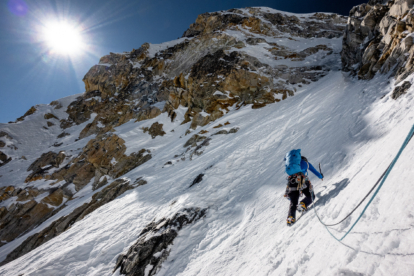A Partial Ascent of Mantok 0
Lessons from a close one in Alaska.
Listen to the story
All photos by Drew Smith
The first rock that fell was about the size of a textbook. That pale chunk of granite spun through space at a mesmerizing rate. It bounced once. Twice. Then slammed into my left ankle. The impact sent me twirling around in an awkward pirouette before I slumped onto the anchor.
This isn’t fair, I thought. We’re not even supposed to be here.
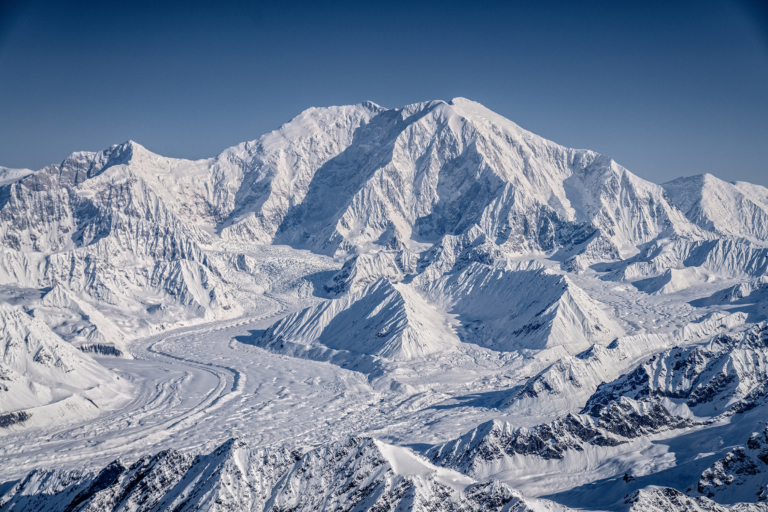
Mount Foraker, or Sultana, the second-highest peak in the Alaska Range, as seen from the plane. Photo: Drew Smith
It was April 2021 in Alaska, and we were halfway up the snowy east face of an unnamed peak. At least, I thought it was the east face. My watch said it was way past noon, yet we were still sweltering in full sun. The slopes above were getting blasted with the same solar energy, and there was little to suggest that the first falling rock would also be the last.
We had flown in with a goal to climb a new route on Mount Russell. This triangular massif towers over the southern end of the central Alaska Range. An assortment of old photographs, satellite imagery and community gossip convinced us that a moderate path existed up its untouched northwest face.
Maximum glory, minimal effort, we thought. All we had to do was get there.
After months of training and preparation, morale was soaring as we buzzed toward destiny in a small plane. But lean snow conditions on the Chedotlothna Glacier below the face caused our pilot to cancel any landing. Instead, he dropped us off 9 miles away on the broad expanse of the Yentna Glacier. The distance might have been surmountable, but several glacial obstacles eliminated Mount Russell as a realistic option. Self-pity set in briefly before we realized we were surrounded by countless other possibilities. So we turned our attention away from Russell and planned to climb one of the unnamed peaks surrounding the Yentna Glacier instead.

The crew watches the light show before their alpine-start for Mantok 0.
The first morning in our unexpected home was spent reading through reports about previous trips to the area. Information was sparse; the main section of the Yentna only seemed to receive a visit from climbers every few years. Freddie Wilkinson and an array of partners ticked some of the best-looking lines in the late 2000s, but a brief reconnaissance ski revealed that plenty of unclimbed stuff remained.
Drew Smith, Grant Kleeves and I rested on a rocky isle in a sea of virgin snow to make a plan. Both of these guys grew up in working-class families in the rural American West. They’re soft-spoken and kind to the core, which often serves as an excellent counter to my perennial crankiness.
In the decade we had spent climbing together, Drew was consistently neat, calm and positive—ideal traits if you’re seeking someone to share a snow cave with. Grant, in contrast, often resembled a walking disaster on flat ground. Yet, no one else I’ve met moves with more speed or grace on steep ice.
Over coffee fortified with butter and coconut, we devised a scheme to tag the top of a pointy, unnamed peak. The peak lay along a ridge that ran from Mantok II past Mantok I, so we began calling it Mantok 0. Our scheme was to link a series of snowy ramps and narrow couloirs up its east face to gain a rime-coated ridge that we hoped would lead to its summit.
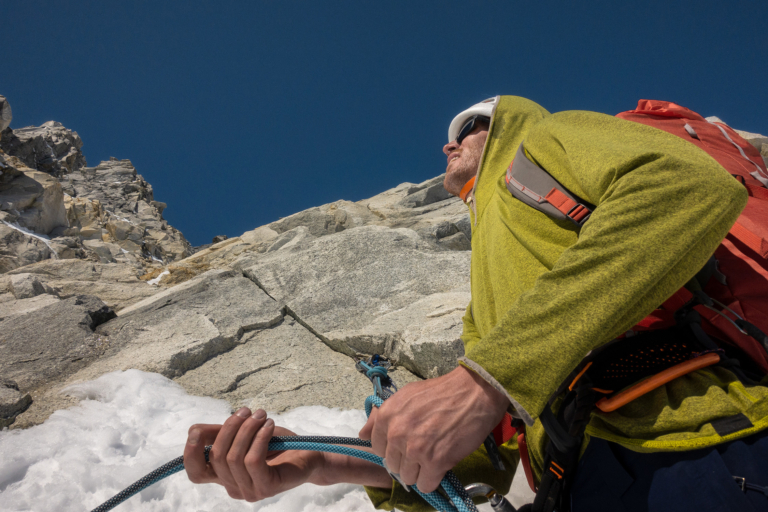
“I looked up to see a microwave-sized menace tumbling through the air. It bounced once, releasing several more projectiles, before crashing into the snow a few feet above where Grant clung to his ice tools.”
We set out at night under the eerie glow of a mild aurora borealis. Apprehension stymied any chattiness. The steady rhythm of skis gliding underfoot was the only sound besides an occasional gust of katabatic air. My mind alternated between intense bouts of doubt and optimism. Dawn stretched for an eternity as a sliver of subarctic sun slid across, rather than rose over, the horizon.
Normalcy returned at the base of the wall when our thoughts turned to familiar tasks. Harnesses were cinched, crampons secured and ropes stacked as we joked about how the approach had taken twice as long as expected. Grant was racking up when Drew asked, “Doesn’t it feel kinda warm for Alaska?”
His question lingered for a moment while my ambition searched for an excuse to deny reality. Before silence forced me to accept it, Drew interrupted himself with a second question clarifying our planned climbing route. I welcomed the change of subject. A few minutes later, Grant headed up on the first lead.
We rallied up the lower mountain while the light of day revealed our dramatic surroundings. Ice or rock in all directions. Unclimbed peak after unclimbed peak. The only sign of human existence was our own ski track.
Grant and Drew each completed a solid shift charging up the calf-deep snow before it was my turn to lead. I was sweating within minutes. I stripped down to a single baselayer. Then I sweat some more. The heat was undeniable. I continued upward.
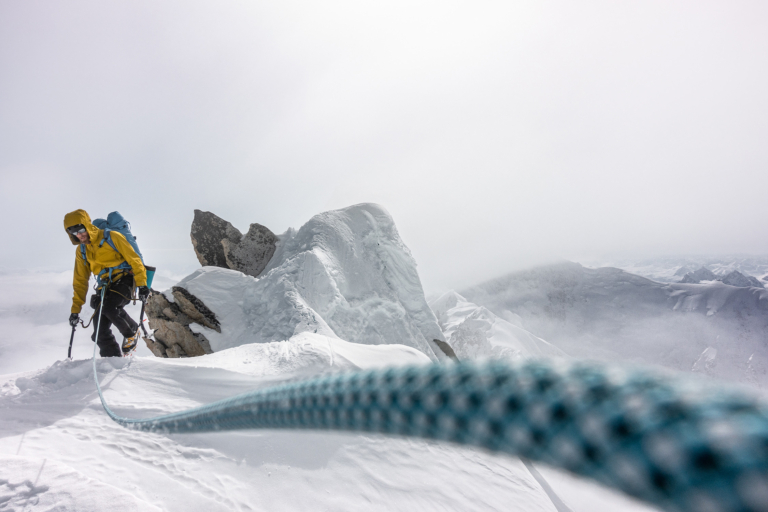
A few days after the close call on Mantok 0, the trio attempted another unclimbed peak but ended up bailing again after a day and a night on the route.
Eventually the angle steepened, and I stopped at the base of a small rock slab to prepare for what appeared to be trickier climbing above. As Grant and Drew were reaching my position, the first rock fell and struck my ankle, followed by pain, relief and irrational gripes about fairness in the mountains. I stood up to test my ankle. It hurt, of course, but it still felt functional.
“I thought we would be safe beneath this slab,” I apologized. “We’re definitely not.”
Drew pointed out a crack splitting a steeper wall 40 feet to our left. Grant had already begun traversing toward it. His wiry frame shuffled along with robotic efficiency. Left ice tool, then left foot. Right ice tool, then right foot. Repeat.
Halfway there he was stalled by a shower of spindrift. Ever-supportive teammates, Drew and I laughed while the stream of powdery snow snuck its way inside Grant’s sleeves and collar. When the spindrift finally stopped, he pressed onward. But his progress ceased again with the thunk of another falling rock.
I looked up to see a microwave-sized menace tumbling through the air. It bounced once, releasing several more projectiles, before crashing into the snow a few feet above where Grant clung to his ice tools. A cloud of white went up, followed by a sickening moan.
Drew grabbed the ropes to reduce the force of what was sure to be a limp body falling onto my anchor. But the cloud of snow cleared and Grant remained exactly where he’d been.
“Grant! Are you OK!?” I shouted.
Silence.
“Grant, tell us you’re OK!” Drew pleaded.
More silence.
“Uh … I … uh … I,” Grant stammered. “… I think I’m OK.”
He turned his head slowly side to side.
“Awesome!” I replied. “Then just keep going!”
“Keep going where?” he asked.
Drew and I exchanged a nervous glance.
“Keep going left,” Drew said calmly. “Keep traversing toward that crack.”
“Oh yeah …” he remembered. “Give me a sec.”
He paused for a long, deep breath. Then he resumed the traverse. His once robotic movements now appeared unsteady.
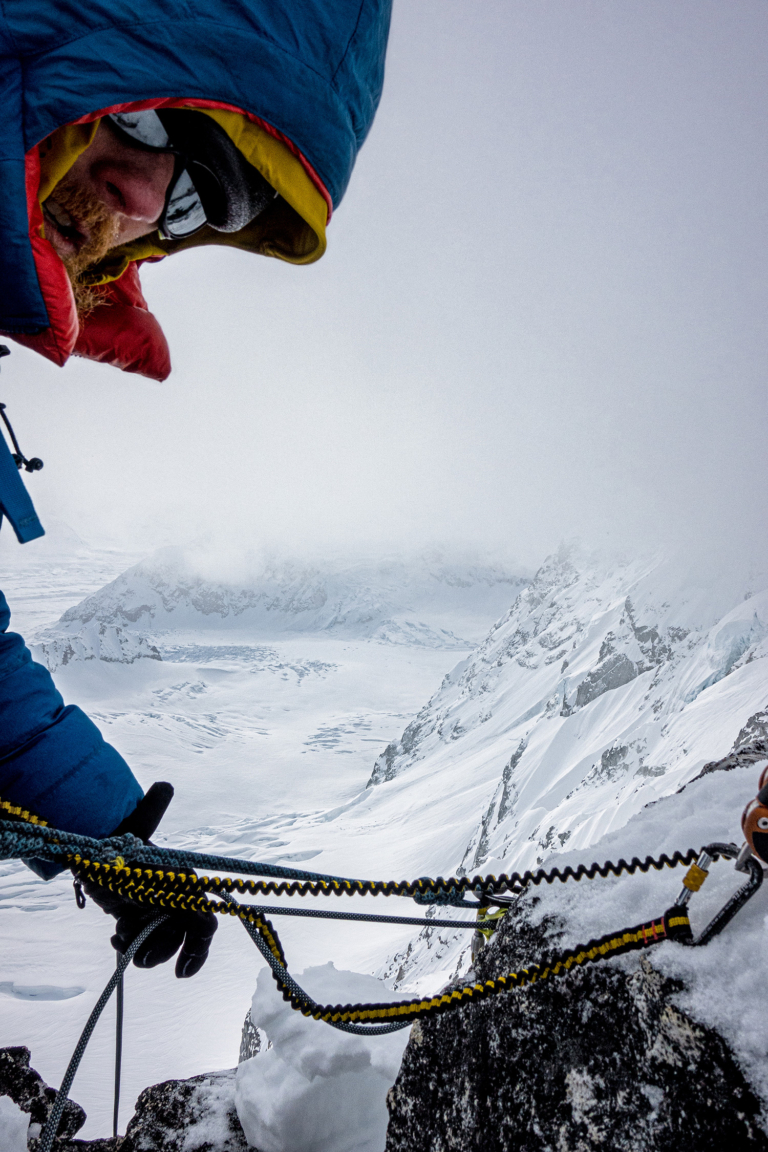
On belay in the Alaska Range—on a less sunny day.
Drew and I were transfixed on his progress. When he began kicking in a stance at the base of the crack, we exchanged another nervous glance. Grant struggled to build an anchor in the seemingly obvious crack. The delay was distressing. Drew untangled a knot of rope while I fiddled with my harness. Anything to distract us from the increasingly inexplicable delay. As soon as Grant shouted “off belay” we were racing toward him.
When we got to Grant, we saw that his helmet was smashed and there was a fresh gash in his backpack. But otherwise, he displayed the same gentle smile as always. He’d managed to position the belay beneath an overhang that sheltered us from further rockfall. Drew examined Grant’s skull and shoulders and found only one minor abrasion. I questioned Grant about where we were and what had happened. He answered everything competently.
A strange calm settled over us. Moments before we had been 2,000 feet up an unclimbed face with a mountain falling down all around us. Now we were safe.
We settled in to wait for shade to arrive and refreeze the nearby slopes. Perched in that absurd location, I marveled at our choice to climb despite the heat. We were all emotional. The mood recovered, but our conversation stalled when the adrenaline wore off. In the silence that ensued, I brooded over my own mistakes. Why did I ignore such obvious warning signs?
I’m reluctant to admit that this wasn’t the first time I’d ignored excessive heat in the mountains. Three years earlier, still air and direct sunlight released an enormous rock that shattered my partner’s leg. With the help of several nearby climbers and an Argentine Army helicopter, she narrowly survived an agonizing and prolonged rescue. The thought that I had not been able to learn from that ordeal was almost too upsetting to confront. Why was my tolerance for risk so out of whack?
There is a belief among some gambling addicts that the luckiest someone can get the first time they visit a casino is to lose all their money. For those fortunate enough, the pain of an initial loss can be so severe that it steers them away from the tables and slots for the rest of their lives.
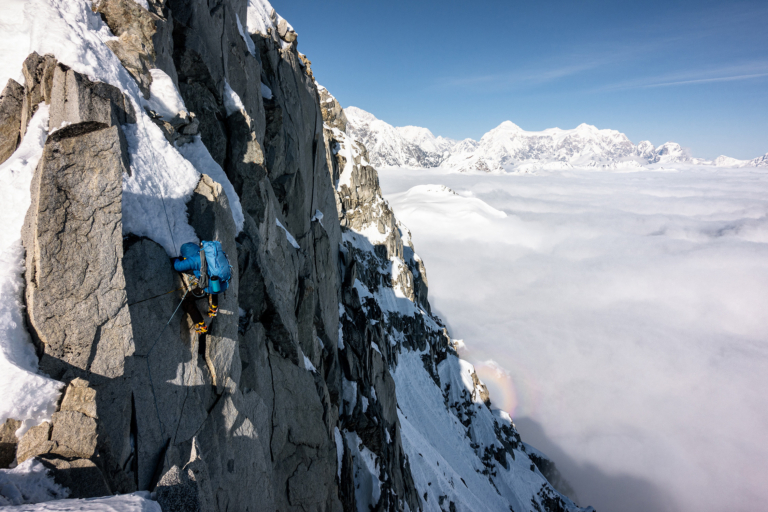
Grant enters into the unknown on the second unclimbed peak of the trip.
By that logic, the first decade I spent in the mountains was extremely unlucky. Year after year, I enjoyed consistent success against ever-slimmer odds. And the feeling of that success fostered an insatiable appetite for more.
For a while, this was possible as my skills grew in step with my goals, but eventually, they could not keep pace. To overcome the deficiency, I substituted safety for skill, and that allowed me to enjoy success a little longer.
It’s an easy substitution to make. Ditching a piece of protection or climbing unroped is a liberating choice that can greatly enhance your speed. And when these kinds of choices pay off, it is often celebrated.
That morning we’d chosen to ignore a sunny forecast and unusually warm temps. This disregard granted us a chance to climb on a day when we knew that we shouldn’t. It’s easy to focus on how this mistake nearly resulted in tragedy, but what I find even more terrifying is how the same mistake nearly resulted in success. If we had been just a couple hundred feet higher when the rockfall occurred, it would have been safely below us, and there would have been little standing between us and the summit. I had come mighty close to another gamble, another jackpot.
Shadows grew around us while I came to this realization. A few hours passed with no further rockfall before we hesitantly agreed to descend. I went first, rappelling gingerly to minimize the load on our anchor and my swollen ankle. Grant and Drew followed silently, lost in their own thoughts. After several more rappels and much down climbing, we reached the safety of the glacier.
The next day we tried to sleep in, but temperatures inside our tents soon rose to tropical levels. Out in the blinding sun, we toasted our survival with champagne. The metal cups we raised were stained from coffee, and their acidic notes tainted the sweet bubbles. Our euphoria was tainted with its own acidic flavor—an inescapable sense of failure.
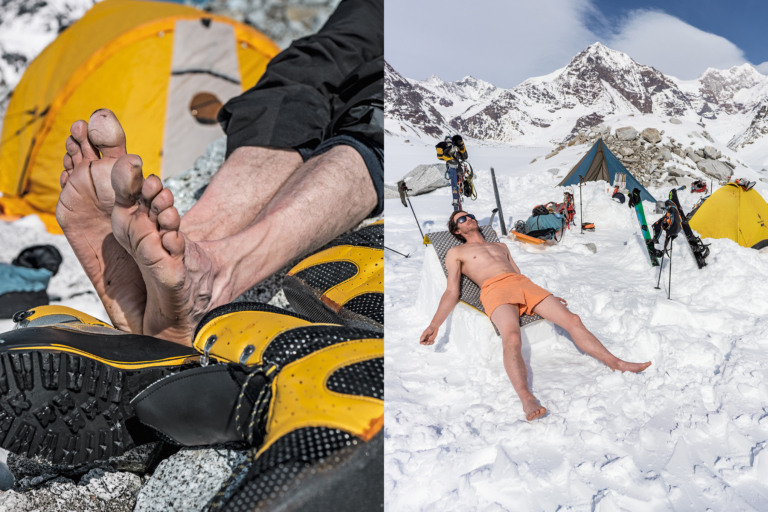
Left: Drying out soaked feet.
Right: The author embraces the heat at base camp.
I still think about that odd concoction. One part joy, one part sadness. How would that mood have differed if we had escaped the rockfall and tagged the summit? Likely the aura of success would have masked any concerns about our decision-making.
On the other hand, if we had acknowledged the dangerous heat and turned around at the base, I doubt we would have celebrated. The choice would have been the right one, but there would have been little feedback to confirm it.
In terms of summits, this trip was a failure. Yet I’ve become increasingly grateful for our disappointment. It’s an unpleasant feeling, for sure, but it serves as precious feedback to adjust my attitude toward risk. I don’t plan to stop chasing summits, but with a little luck, and a few more failures, I might learn to place smarter bets in the mountains.
